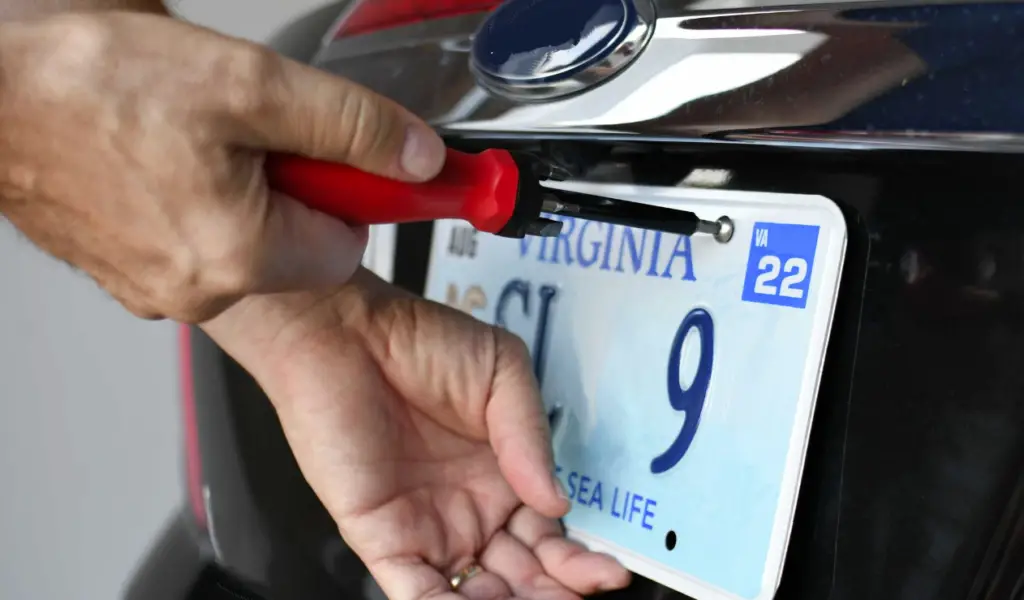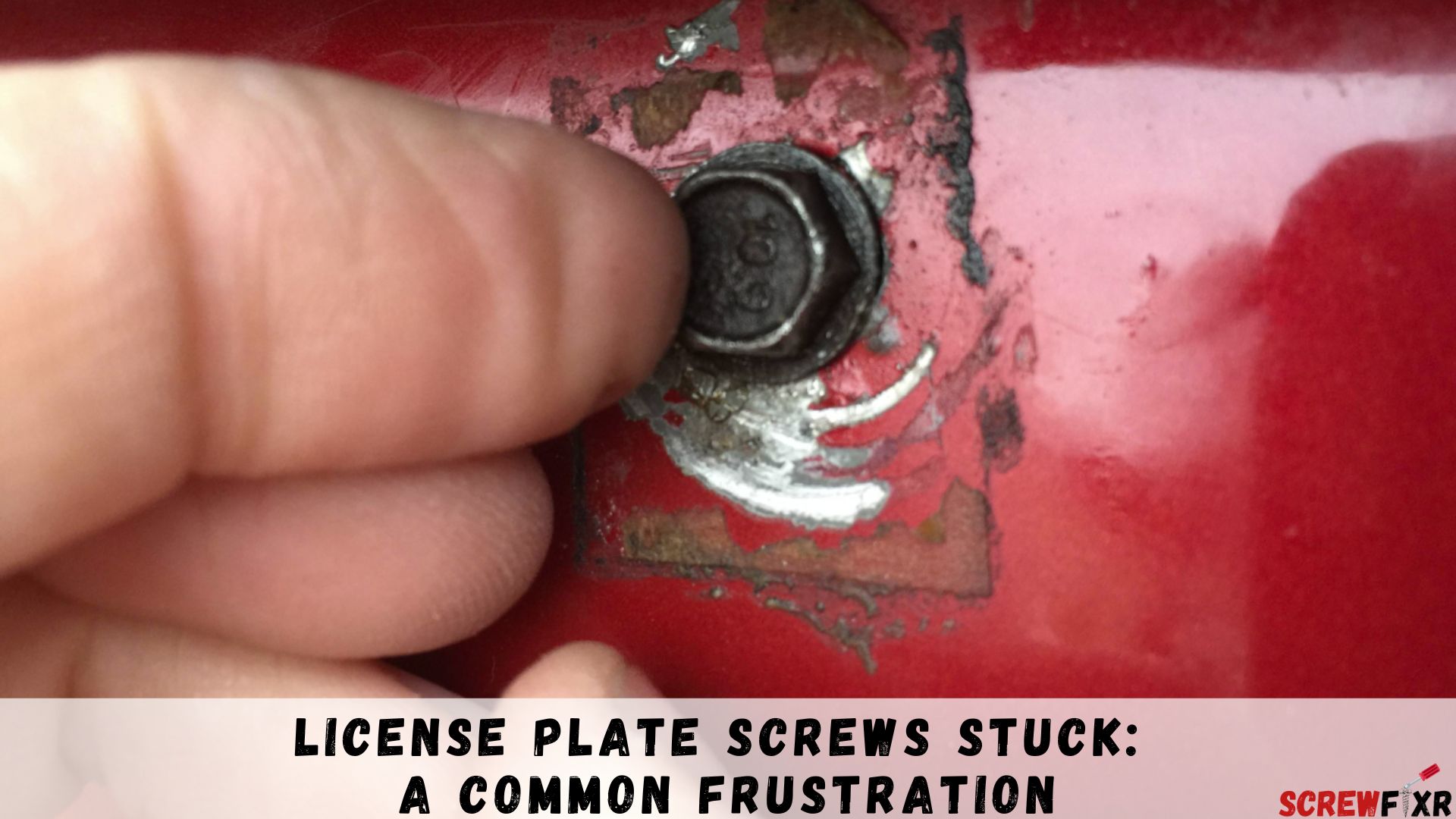License plate screws may seem like a small and inconsequential part of your vehicle, but when they get stuck, they can cause a big headache. Whether you’re dealing with rusted screws or screws that just won’t budge, this guide is here to help. We’ll walk you through the steps to handle License Plate Screws Stuck, providing practical solutions and valuable insights.
License Plate Screws Stuck: A Common Frustration

Dealing with License Plate Screws Stuckness can be an exasperating experience. Whether you’re trying to replace your license plate or access something behind it, stuck screws can quickly turn a simple task into a frustrating ordeal.
Understanding the Problem
Before diving into solutions, let’s first understand why license plate screws get stuck in the first place. There are various factors that can contribute to this problem:
- Rust and corrosion: Over time, exposure to the elements can lead to rust and corrosion, making screws difficult to remove.
- Over-tightening: Sometimes, screws are fastened too tightly during installation, making them stubborn to loosen later.
- Low-Quality Screws: Inexpensive or low-quality screws may be more prone to rust and breakage.
- Incorrect Tools: Using the wrong tools or techniques can also lead to screws getting stuck.
How to Get Rusted Screws off License Plate

Getting rusted screws off a license plate can be a challenging task, but with the right approach and tools, you can successfully remove them without causing damage. Here’s a step-by-step guide to help you get those stubborn, rusted screws off your license plate:
Step 1: Gather Your Tools
Before you begin, make sure that you have gathered all the necessary tools and materials:
- Penetrating oil (e.g., WD-40)
- A screwdriver or socket wrench
- Pliers
- Safety glasses
- Gloves
- A rubber mallet (optional)
Step 2: Apply Penetrating Oil
Start by spraying a generous amount of penetrating oil (such as WD-40) directly onto the rusted screws. Allow the oil to penetrate for at least 15 minutes. The oil will help break down the rust and make it easier to turn the screws.
Step 3: Choose the Right Tool
After the penetrating oil has had time to work, select the appropriate tool for the job. If the screw heads are still in good condition, use a screwdriver or socket wrench that fits the screw heads snugly. If the screw heads are damaged or rusted, you may need to use pliers.
Step 4: Apply Even Pressure
With your chosen tool, apply even pressure to the screw while turning it counterclockwise (lefty loosey). It’s crucial to maintain a steady and firm grip to avoid stripping the screw head. If you encounter resistance, stop and apply more penetrating oil.
Step 5: Use a Rubber Mallet (if needed)
If the screws are exceptionally stubborn, you can tap the screwdriver or socket wrench gently with a rubber mallet while turning it counterclockwise. This tapping can help break the rust’s grip on the threads.
Step 6: Be Patient and Persistent
Rusted screws may require patience and persistence. It’s essential to avoid rushing the process to prevent damaging the screws or the surrounding area. Continue turning the screws slowly and steadily.
Step 7: Clean and Lubricate
Once you’ve successfully removed the rusted screws, clean the screw holes and the back of the license plate. Remove any remaining rust or debris. Applying a light coat of anti-seize lubricant to the new screws before installation can help prevent future rust issues.
Step 8: Install New Screws
If the old screws are too damaged or rusted to reuse, replace them with new screws. Make sure to use the appropriate size and type of screws for your license plate.
By following these steps and taking your time, you can safely remove rusted screws from your license plate without causing further damage. Remember that patience and the right tools are key to a successful outcome.
How to Take Off License Plate Without Screwdriver
To remove a license plate without a screwdriver, you can try the following methods:
- Bend and Pull Method: Hold the sides of the license plate and gently bend it up and down while pulling it towards you. This can help stretch the holes and loosen the plate.
- Use Vise Grips: If the license plate screws have heads that can be gripped, you can use Vise grips to grab hold of them and unscrew them like bolts.
- Hit with a Hammer: If the license plate screws are stuck and won’t budge, you can try hitting a wrench attached to the screw in a tightening position with a hammer. This impact can help loosen the screws.
- Rubber Band Method: Wrap a rubber band around the head of the screw and press it firmly while turning counterclockwise. The rubber band can provide extra grip and traction to help remove the screws.
Remember to exercise caution when using these methods to avoid damaging the license plate or surrounding areas.
Frequently Asked Questions

What should I do if the screw head is stripped?
If the screw head is stripped, you can try using a rubber band or a specialized stripped screw extractor tool to grip and turn the screw.
Can I use household oils like vegetable oil instead of penetrating oil?
While household oils can work in a pinch, penetrating oils are specifically designed to break down rust and are more effective.
Is it safe to apply heat to the screw if my license plate is made of plastic?
No, applying heat can damage plastic components. If your license plate is near plastic parts, use the heat method with caution.
What if the screw breaks off completely?
If the screw breaks, you may need to drill it out carefully, re-thread the hole, and use a new screw.
Can I prevent license plate screws from getting stuck in the first place?
Yes, using anti-seize lubricant during installation is a proactive way to prevent future issues with stuck screws.
Are stainless steel screws less likely to get stuck?
Stainless steel screws are more resistant to rust and corrosion, making them a good choice to avoid this problem.
Conclusion
Dealing with License Plate Screws Stuck can be frustrating, but with the right approach, you can overcome this common issue. Remember to use penetrating oil, the right tools, and the appropriate techniques to loosen stuck screws. Additionally, consider preventive measures like using anti-seize lubricant for smoother installations in the future.


